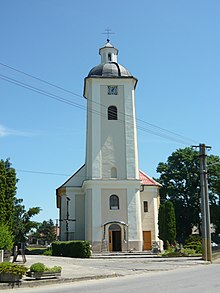Ostratice
| Ostratice | ||
|---|---|---|
| coat of arms | map | |

|
|
|
| Basic data | ||
| State : | Slovakia | |
| Kraj : | Trenčiansky kraj | |
| Okres : | Partizánske | |
| Region : | Horná Nitra | |
| Area : | 11.308 km² | |
| Residents : | 793 (Dec. 31, 2019) | |
| Population density : | 70 inhabitants per km² | |
| Height : | 182 m nm | |
| Postal code : | 958 34 | |
| Telephone code : | 0 38 | |
| Geographic location : | 48 ° 39 ' N , 18 ° 17' E | |
| License plate : | PE | |
| Kód obce : | 505307 | |
| structure | ||
| Community type : | local community | |
| Structure of the municipality: | 2 parts of the community | |
| Administration (as of November 2018) | ||
| Mayor : | Stanislav Margolien | |
| Address: | Obecný úrad Ostratice č. 200 956 34 Ostratice |
|
| Website: | www.obecostratice.sk | |
| Statistics information on statistics.sk | ||
Ostratice (Hungarian Sándori ) is a municipality in the west-center of Slovakia with 793 inhabitants (as of December 31, 2019), which belongs to the Okres Partizánske , part of the Trenčiansky kraj .
geography
The municipality is located in the northern part of the Nitrianska pahorkatina hills on the left bank of the Bebrava . The center of the village is at an altitude of 182 m nm and is nine kilometers from Partizánske .
Administratively, the municipality consists of the municipality parts Malé Ostratice (Hungarian Kissándori - until 1907 Kissztrice ) and Veľké Ostratice (Hungarian Nagysándori - until 1907 Nagysztrice ). Trebašovce , which was incorporated after 1808 , is no longer part of the municipality today.
Neighboring municipalities are Rybany in the north, Pravotice in the northeast, Nedašovce in the east, Partizánske ( Malé Bielice district ) in the southeast, Žabokreky nad Nitrou and Chynorany in the south, Nadlice in the southwest and Livina in the west.
history
The municipality of Ostratice was settled in the Neolithic Age, later there was a settlement of the Lusatian culture .
The original place was first mentioned in 1193 as Strece , in 1338 the village was called Streche . Until 1439 the community was divided into two independent places, Veľké Ostratice and Malé Ostratice, which were called Also Streche and Felse Streche in the year mentioned .
Veľké Ostratice was owned by the Ostratický , Pogány , Macskó , Giczy and Zsambokréthy families after 1439 . In 1598 there were 27 houses here, in 1712 12 taxpayers lived in the village. In 1784 the village had 21 houses, 36 families and 180 inhabitants, in 1828 there were 15 houses and 236 inhabitants who were employed as farmers.
In 1598 there were 16 houses and a mill in Malé Ostratice, in 1720 seven taxpayers lived here. In 1784 the village had 40 houses, 62 families and 279 inhabitants, in 1828 there were 36 houses and 362 inhabitants who were employed as farmers.
Until 1918, both places in Neutra County belonged to the Kingdom of Hungary and then came to Czechoslovakia or now Slovakia. In 1960 Malé Ostratice and Veľké Ostratice merged to form the municipality of Ostratice.
population
According to the 2011 census lived in Ostratice 866 inhabitants, of which 834 Slovaks , two Poles and Czechs and German . 27 residents did not provide any information on ethnicity .
761 residents committed themselves to the Roman Catholic Church, six residents to the Evangelical Church AB, five residents each to the Apostolic Church and the Pentecostal movement; two residents professed a different denomination. 31 residents had no denomination and the denomination of 56 residents was not determined.
Buildings
- Baroque style Roman Catholic church from 1737
- originally two country castles with a common courtyard in Malé Ostratice, one built in the Renaissance style in the 16th century. Both were rebuilt and united around 1820.
- two country estates in the classical style from the first third of the 19th century
traffic
In Ostratice there is a stop on the Chynorany – Trenčín railway line .
Personalities
Sons and Daughters of the Church:
- Anton Mária Vácval SDB (1908–2000), Catholic priest , youth minister , historian
Web links
- Entry on e-obce.sk (Slovak)
Individual evidence
- ↑ Results of the 2011 census (Slovak)
- ↑ Zlatko Kubanovič: Historický náhľad do dejín slovenských saleziánov (Od dona Bosca do roku 1924) . Don Bosco, Bratislava 2019. ISBN 978-80-8074-436-6 . Pp. 287-288.

